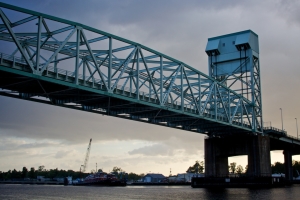Update: Cape Fear Memorial Bridge Preservation Project Scheduled to Begin Mid-January
People in the Wilmington area should prepare for travel impacts on the Cape Fear Memorial Bridge to begin after the holidays.
“While the bridge is safe, it is in need of critical repairs,” said Division Engineer Chad Kimes. “We need to start the project now to ensure enough time to complete this work before hurricane season and the start of the busy summer season.”
Work on a scheduled project to lengthen the lifespan of the bridge is set to begin in mid-January.
“It’s an old bridge that needs attention as soon as possible to give Wilmington-area residents and tourists a way to travel between Brunswick and New Hanover counties for many years to come, until the bridge can be replaced,” said Wilmington Urban Area Metropolitan Planning Organization’s Executive Director Mike Kozlosky.
The current plan is tentatively scheduled to begin the evening of Jan. 11.
- The contractor will close the outside lanes in both directions of the bridge nightly from 7 p.m. to 5 a.m.
- This closure will allow crews to safely create a platform to use during the project.
- Once the platform is complete, the outside lanes will reopen and the inside lanes in each direction will close overnight for crews to build a barrier wall.
As early as Jan. 28, crews will begin the preservation project.
- This work includes replacing the grid deck and its support beams.
- Crews will work seven days a week during daylight hours.
- Both eastbound lanes heading into Wilmington will be closed and travelers using the westbound lanes will not be affected during this part of the project.
The timing of the eastbound closure is dependent on the availability of materials needed for that part of the project. Due to the age of the bridge, there are limited suppliers who can provide the needed materials. Faced with disruption in the supply chain, NCDOT took proactive steps prior to a contract being awarded to begin securing materials for the project.
Detour Routes
During the eastbound closure, drivers can take Isabel Holmes Bridge, Martin Luther King Jr. Boulevard and College Road or Interstate 140. NCDOT will use message boards to alert drivers to the optimal route. NCDOT will not resurface I-140 until after the bridge project is complete.
Wilmington officials say commercial trucks will not be allowed to use Third Street.
“Our team continues to coordinate with NCDOT and the city to understand our traffic flows and ensure early communication to our port-user community,” NC Ports Executive Director Brian Clark said.
Drivers should use caution while traveling through the work zone and plan accordingly for delays. For real-time travel information, visit DriveNC.gov or follow NCDOT on social media.
Future of Wilmington Bridge
The cost to maintain and operate a movable span structure is about $500,000 a year, and the cost continues to rise. NCDOT is continuing to work with its partners, including the Wilmington Urban Area Metropolitan Planning Organization, on the future of the Cape Fear Memorial Bridge.
In February 2022, the WMPO voted for NCDOT to look at all possible funding options for the bridge. In response, NCDOT has explored different funding options for a replacement bridge and conducted a Traffic and Revenue study.
Preliminary engineering is funded in the state’s prioritization plan. While construction of a replacement bridge is not included in the plan, the WMPO and NCDOT have placed the project in the state’s next round of prioritization to see how it would score using traditional funding models. A traditional funding model would be paid fully by the state, rather than a toll-funded project.
NCDOT also recently applied for a $200 million federal grant, which could be used to pay for a portion of the bridge replacement, as either a traditional or toll funded project, with state matching funds.
Next month, the WMPO is anticipated to decide whether a tolling option should also be included in prioritization. This does not mean the planning organization would be voting for tolling. This would allow NCDOT to continue work on the original vote of the WMPO to look at all funding options. The WMPO, in coordination with NCDOT, would have the ability to remove either option from prioritization.
NCDOT is not advocating for a particular path forward and per state law, any toll project must be approved by the local planning organization.
Source: N.C. Department of Transportation

